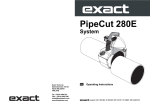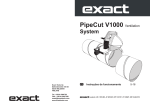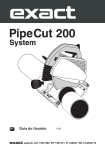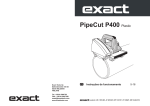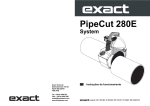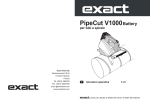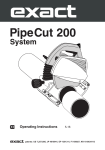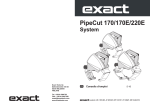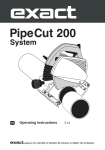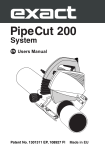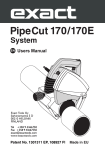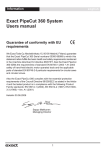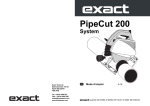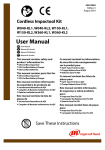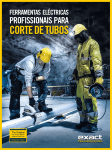Download Exact PipeCut 170 Battery System
Transcript
PipeCut 170 Battery System Exact Tools Oy Särkiniementie 5 B 64 FI-00210 Helsinki Finland Tel +358 9 4366750 Fax +358 9 43667550 exact @exacttools.com www.exacttools.com EN Operating Instructions 5-22 patents: US 7,257,895, JP 4010941, EP 1301311, FI 108927, KR 10-0634113 Exact PipeCut 170 Battery System Blade information for Exact PipeCut 170 Battery Use only Exact PipeCut Blade type Cermet 140 Thin with Exact PipeCut 170 Battery saw Exact PipeCut 170 Battery System Battery charger and its parts 1. 2. 3. 4. 5. 6. 7. 2 Green LED indicator Red LED indicator Charger Air cooling vents Battery compartment Battery pack Power cord with EU socket 3 Declaration of Conformity We declare under our sole responsibility that the products described under “Technical Data” are in conformity with the following standards or standardization documents: EN60745-1, EN60745- 2-5, EN55014-1, EN 55014-2, EN61000-3-2, EN61000-3-3 according to the provisions of the directives 2004/108/EC, 2006/42/EC. For more information, please contact Exact Tools at the following address. The technical fi le is available at the address underneath. The person authorized to compile the technical file: Mika Priha, R&D manager ([email protected]) Helsinki, 05.01.2015 Seppo Makkonen, Managing director Exact Tools Oy Särkiniementie 5 B 64 FI-00210 Helsinki Finland 4 Contents The original language of this manual is English english Contents 6. Technical data 7. Package contents Safety 8. Safety instructions 10.Intended use and product features Battery Charger 11. Charger information 11. Charger safety instructions 14.Charger operation 16.Charger maintenance, environment and guarantee Operation 17.Before operating the tool 17.Mounting the battery 17.Precise setting of the cutting point 17.Setting the pipe on supports 18.Attaching the pipe saw to the pipe 18.Piercing the pipe wall 18.Sawing around a pipe 19.Control card 19.Straightness of cut and adjusting wheel 20.Installing and changing the saw blade 21.Service and maintenance instructions 22.Environment /Disposal 22.Guarantee/Guarantee conditions 22.Tips for users Exploded view (separate attachment) Definitions: Safety guidelines The definitions below describe the level of severity for each signal word. Please read the manual and pay attention to these symbols. DANGER: Indicates an imminently hazardous situation which, if not avoided, will result in death or serious injury. WARNING: Indicates a potentially hazardous situation which, if not avoided, could result in death or serious injury. CAUTION: Indicates a potentially hazardous situation which, if not avoided, may result in minor or moderate injury. NOTICE: Indicates a practice not related to personal injury which, if not avoided, may result in property damage. Denotes risk of electric shock. 5 Information english Operating, safety, and servicing instructions Please read this operating, safety, and servicing instructions carefully before using the pipe saw. Also store this instruction book somewhere accessible to everyone using the pipe saw. In addition to these instructions, always follow the official work, health and safety regulations. The Exact PipeCut 170 Battery is meant for professional use only. Technical data Model Voltage No-Load speed Intermittent operation Blade diameter Mounting bore Weight Range of use Ø Pipecut 170 Battery 18 V / DC 3500 r/min 1,5 min ON / 8,5 min OFF (S3 15%) 140 mm (5.51”) 62 mm (2,44”) 5,2/6,0 kg (11/13 lbs) 15 mm - 170 mm (0,6”- 6”) Max. pipe wall steel 6 mm (0,23”) Max. pipe wall plastics 14 mm (0,55”) Spindle lock YES Vibration ah <2,5 m/s2 LpA (sound pressure) 86 dB(A) KpA (sound pressure uncertanity) LWA (acoustic power) KWA (acoustic power uncertanity) 3 dB(A) 97dB(A) 3 dB(A) Noise/Vibration Information Measured values determined according to EN60745. Wear hearing protection! Vibration total values (triax vector sum) determined according to EN60745: Vibration emission value ah <2,5 m/s2, UncertaintyK =1.5 m/s2. The vibration emission level given in this information sheet has been measured in accordance with a standardised test given in EN 60745 and may be used to compare one tool with another. It may be used for a preliminary assessment of exposure. WARNING: The declared vibration emission level represents the main applications of the tool. However if the tool is used for different applications, with different accessories or poorly maintained, the vibration emission may differ. This may significantly increase the exposure level over the total working period. An estimation of the level of exposure to vibration should also take into account the times when the tool is switched off or when it is running but not actually doing the job. This may significantly reduce the exposure level over the total working period. Identify additional safety measures to protect the operator from the effects of vibration such as: maintain the tool and the accessories, keep the hands warm, organisation of work patterns. 6 Information english Exact PipeCut 170 Battery pipecutting system, Package contents: Please check the package contains the following items: 1. Pipecutting System case In the bigger compartment there should be the following items: 2. 3. 4. 5. 6. 7. Exact PipeCut 170 Battery pipe saw Cutting supports 4× Operating instructions Hex socket key 5 mm and 2 mm fitted to the machine TCT thin blade 140 × 62 fitted on the machine DVD-video disc with instructions In the smaller compartment there should be the following items: 8. Battery x 2 9. Charger with EU plug 7 Safety english General power tool safety warnings attached to a rotating part of the power tool may result in personal injury. e) Do not overreach. Keep proper footing and balance at all times. This enables better control of the power tool in unexpected situations. f) Dress properly. Do not wear loose clothing or jewellery. Keep your hair, clothing and gloves away from moving parts. Loose clothes, jewellery or long hair can be caught in moving parts. g) If devices are provided for the connection of dust extraction and collection facilities, ensure these are connected and properly used. Use of dust collection can reduce dust-related hazards. WARNING: Read all safety warnings and all instructions. Failure to follow the warnings and instructions may result in electric shock, fire and/or serious injury Save all warnings and instructions for future reference. The term “power tool” in the warnings refers to your mains-operated (corded) power tool or battery-operated (cordless) power tool. 1. Work area safety 4. Power tool use and care a) Keep work area clean and well lit. Cluttered or dark areas invite accidents. b) Do not operate power tools in explosive atmospheres, such as in the presence of flammable liquids, gases or dust. Power tools create sparks which may ignite the dust or fumes. c) Keep children and bystanders away while operating a power tool. Distractions can cause you to lose control. a) Do not force the power tool. Use the correct power tool for your application. The correct power tool will do the job better and safer at the rate for which it was designed. b) Do not use the power tool if the switch does not turn it on and off. Any power tool that cannot be controlled with the switch is dangerous and must be repaired. c) Disconnect the plug from the power source or remove the battery from the power tool before making any adjustments, changing accessories, or storing power tools. Such preventive safety measures reduce the risk of starting the power tool accidentally. d) Store idle power tools out of the reach of children and do not allow persons unfamiliar with the power tool or these instructions to operate the power tool. Power tools are dangerous in the hands of untrained users. e) Maintain power tools. Check for misalignment or binding of moving parts, breakage of parts and any other condition that may affect the power tool’s operation. If damaged, have the power tool repaired before use. Many accidents are caused by poorly maintained power tools. f) Keep cutting tools sharp and clean. Properly maintained cutting tools with sharp cutting edges are less likely to bind and are easier to control. g) Use the power tool, accessories and tool bits etc. in accordance with these instructions, taking into account the working conditions and the work to be performed. Use of the power tool for operations different from those intended could result in a hazardous situation. 2. Electrical safety a) Power tool plugs must match the outlet. Never modify the plug in any way. Do not use any adapter plugs with earthed (grounded) power tools. Unmodified plugs and matching outlets will reduce risk of electric shock. b) Avoid body contact with earthed or grounded surfaces, such as pipes, radiators, ranges and refrigerators. There is an increased risk of electric shock if your body is earthed or grounded. c) Do not expose power tools to rain or wet conditions. Water entering a power tool will increase the risk of electric shock. d) Do not abuse the cord. Never use the cord for carrying, pulling or unplugging the power tool. Keep cord away from heat, oil, sharp edges and moving parts. Damaged or entangled cords increase the risk of electric shock. e) When operating a power tool outdoors, use an extension cord suitable for outdoor use. Use of a cord suitable for outdoor use reduces the risk of electric shock. f) If operating a power tool in a damp location is unavoidable, use a residual current device (RCD) protected supply. Use of an RCD reduces the risk of electric shock. 5) Battery tool use and care a) Recharge only with the charger specified by the manufacturer. A charger that is suitable for one type of battery pack may create a risk of fire when used with another battery pack. b) Use power tools only with specifically designated battery packs. Use of any other battery packs may create a risk of injury and fire. c) When battery pack is not in use, keep it away from other metal objects, like paper clips, coins, keys, nails, screws or other small metal objects, that can make a connection from one terminal to another. Shorting the battery terminals together may cause burns or a fire. d) Under abusive conditions, liquid may be ejected from the battery; avoid contact. If contact accidentally occurs, flush with water. If liquid contacts eyes, additionally seek medical help. Liquid ejected from the battery may cause irritation or burns. 3. Personal safety a) Stay alert, watch what you are doing and use common sense when operating a power tool. Do not use a power tool while you are tired or under the influence of drugs, alcohol or medication. A moment of inattention while operating power tools may result in serious personal injury. b) Use personal protective equipment. Always wear eye protection. Protective equipment such as dust mask, non-skid safety shoes, hard hat, or hearing protection used for appropriate conditions will reduce personal injuries. c) Prevent unintentional starting. Ensure the switch is in the off-position before connecting to power source, picking up or carrying the tool. Carrying power tools with your finger on the switch or energising power tools that have the switch on invites accidents. d) Remove any adjusting key or wrench before turning the power tool on. A wrench or a key left 6) Service a) Have your power tool serviced by a qualified repair person using only identical replacement parts. This will ensure that the safety of the power tool is maintained. 8 Safety english Safety warnings for circular saws a) Further safety instructions for all saws Causes and operator prevention of kickback: - Kickback is a sudden reaction to a pinched, bound or misaligned saw blade, causing an uncontrolled saw to lift up and out of the work piece toward the operator; - When the blade is pinched or bound tightly by the kerf closing down, the blade stalls and the motor reaction drives the unit rapidly back toward the operator; - If the blade becomes twisted or misaligned in the cut, the teeth at the back edge of the blade can dig into the top surface of the pipe causing the blade to climb out of the kerf and jump back toward the operator. Kickback is the result of saw misuse and/or incorrect operating procedures or conditions and can be avoided by taking proper precautions as given below: a) Maintain a firm grip with both hands on the saw and position your arms to resist kickback forces. Position your body to either side of the blade, but not in line with the blade. Kickback could cause the saw to jump backwards, but kickback forces can be controlled by the operator, if proper precautions are taken. NOTE: For circular saws with 140 mm or smaller diameter blades, the words “with both hands” may be omitted. b) When blade is binding, or when interrupting a cut for any reason, release the trigger and hold the saw motionless in the material until the blade comes to a complete stop. Never attempt to remove the saw from the work or pull the saw backward while the blade is in motion or kickback may occur. Investigate and take corrective actions to eliminate the cause of blade binding. c) When restarting a saw in the work piece, centre the saw blade in the kerf and check that saw teeth are not engaged into the material. If saw blade is binding, it may walk up or kickback from the work piece as the saw is restarted. d) Support long pipes to minimise the risk of blade pinching and kickback. Long pipes tend to sag under their own weight. Supports must be placed under the pipe on both sides, near the line of cut and near the edge of the pipe. e) Do not use dull or damaged blades. Unsharpened or improperly set blades produce narrow kerf causing excessive friction, blade binding and kickback. f) Use extra caution when making a “plunge cut” into existing walls or other blind areas. The protruding blade may cut objects that can cause kickback. DANGER: Keep hands away from cutting area and the blade. Keep your second hand on motor housing. If both hands are holding the saw, they cannot be cut by the blade. NOTE: For circular saws with 140 mm or smaller diameter blades, the “Keep your second hand on auxiliary handle, or motor housing” may be omitted. b) Do not reach underneath the work piece. The guard cannot protect you from the blade below the work piece. c) Adjust the cutting depth to the thickness of the work piece. Less than a full tooth of the blade teeth should be visible below the work piece. d) Never hold the work piece being cut in your hands or across your leg. Secure the work piece to a stable platform. It is important to support the work properly to minimize body exposure, blade binding, or loss of control. e) Hold the power tool only by the insulated gripping surfaces when performing an operation where the cutting tool may contact hidden wiring or its own cord. Contact with a “live” wire will also make exposed metal parts of the power tool “live” and shock the operator. f) Always use blades with correct size and shape (diamond versus round) of arbour holes. Blades that do not match the mounting hardware of the saw will run eccentrically, causing loss of control. g) Never use damaged or incorrect blade washers or bolt. The blade washers and bolt were specially designed for your saw, for optimum performance and safety of operation. h) Do not reach into the saw dust ejector with your hands. They could be injured by rotating parts. i) Do not work overhead with the saw. In this manner you do not have sufficient control over the power tool. j) Do not operate the power tool stationary. It is not designed for operation with a saw table. k) Do not use high speed steel (HSS) saw blades. Such saw blades can easily break. l) When working with the machine, always hold it firmly with both hands and provide for a secure stance. The power tool is guided more secure with both hands. m) Secure the work piece. A work piece supported by pipe holders is held more secure than by hand. n) Always wait until the machine has come to a complete stop before placing it down. The tool insert can jam and lead to loss of control over the power tool. o) Never use the machine with a damaged cable or a damaged battery. Do not touch the damaged cable and pull the mains plug when the cable is damaged while working. Damaged cables increase the risk of an electric shock. Safety instructions for plunge type saws a) Check guard for proper closing before each use. Do not operate the saw if guard does not move freely and enclose the blade instantly. Never clamp or tie the guard with the blade exposed. If saw is accidentally dropped, guard may be bent. Check to make sure that guard moves freely and does not touch the blade or any other part, in all angles and depths of cut. 9 Safety english Battery pipe saw can only be used to cut round pipes, with a diameter of 15-170 mm (0.6”-6”) models and a maximum wall thickness of 6 mm (0.23”) with steel and other ferrous and non-ferrous materials and 14 mm (0.55”) with plastics. The PipeCut 170 Battery pipe saw can be used to cut all normal pipe materials, such as steel, stainless steel, cast iron, copper, aluminium and plastic. PipeCut 170 Battery pipe saw is intended for short, intermittent use. The machine may be loaded for 1,5 minutes during a 10-minute period (S3 15 %). PipeCut 170 Battery pipe saw is not intended for use in industrial production. Use pipe holders to support pipe. b) Check the operation and condition of the guard return spring. If the guard and the spring are not operating properly, they must be serviced §before use. Guard may operate sluggishly due to damaged parts, gummy deposits, or a build-up of debris. c) Always observe that the guard is covering the blade before placing saw down on bench or floor. Additional specific safety rules The pipe saw must never be used in the following cases, if: • • • • • • • • • • There is water or another liquid, explosive gases or poisonous chemicals inside the pipe to be cut. The power switch is faulty. The power cable is faulty, The blade is bent. The blade is blunt or in poor condition. The plastic components are cracked or have parts missing. The gripper unit is not properly tightened around the pipe or if it is warped. The blade guard cover or moving blade guard has been damaged or removed from the machine. The locking mechanisms do not work properly (UNLOCK-button). The pipe saw has become wet. When using PipeCut 170 Battery, remember that it is not as powerful as the PipeCut 170 with cable. Don’t expect the same performance as with the cable model. Even it can cut OD 170 mm and with wall thickness of 6 mm pipes it is designed to be used with OD 120 mm and less with wall thickness of 3 mm and less. USE IT ONLY OCCASIONALLY TO BIGGER PIPES. Product Features While reading the operating instructions, unfold the graphics page for the machine and leave it open. This page is folded under the cover of this manual (page 3). The following numbering of the product features refers to this illustration. When using the pipe saw, the following factors must always be taken into consideration: • • • • • • • • • • Support tubes to minimise the risk of blade pinching. Ensure that the pipe to be cut is empty. Ensure that the blade is correctly installed. Ensure that the diameter and thickness of the blade are suitable for the pipe saw and that the blade is suitable for the rpm-range of the machine. Never use sideways force to stop the blade, always allow the blade to stop freely. Check the attachments of the blade guards. Never use excessive force when using the pipe saw. Never use the pipe saw to lift the pipe while it is still attached to the pipe. Avoid overloading the electric motor. Always follow the safety and operating instructions and current regulations. Figure A2. 1. 2. 3. 4. 5. 6. 7. 8. 9. 10. 11. 12. 13. 14. 15. 16. 17. 18. 19. 20. Functional Description Read all safety warnings and all instructions. Failure to follow the warnings and instructions may result in electric shock, fire and/or serious injury. Intended Use PipeCut 170 Battery: The PipeCut 170 Battery pipe saw is intended for use as a pipe fitter’s tool at the installation site. The PipeCut 170 10 Battery Battery indicator Battery release buttons Blade-guard screw UNLOCK button Power switch Power-switch locking lever Blade-guard cover Moving blade-guard Edge of moving blade-guard Braking wheels Adjusting wheel Operating handle Spindle-lock button Blade key and key for the adjusting wheel Heat indicator light Motor unit Rating plate Gripper unit Gripper unit adjustment knob Charger Information english Operating, safety, and servicing instructions WARNING: DO NOT attempt to operate the tool until you have read and understood all instructions and safety rules contained in this manual. Failure to comply may result in accidents involving fire, electric shock, or serious personal injury. Save this owner’s manual for future reference and review it frequently for safe operation. Technical data Model Voltage input (AC) Voltage output (DC) Current Power DC18EU02 100 - 240 V / 50-60 Hz 16,6 - 20,7 V 4,0 A 80 -100 W Protection class /II Description of the symbols: V = Volts A = Amperes = DC = Direct Current Hz = Herz ~ = AC = Alternating Current = Class II Constuction Guidelines for using extension cords: WARNING! If you are using an extension cord outdoors, be sure it is acceptable for outdoor use. Be sure your extension cord is properly wired and in good electrical condition. Always replace a damaged extension cord or have it repaired by a qualified person before using it. Protect your extension cords from sharp objects, excessive heat, and damp or wet areas. 11 Charger Safety english General safety rules 6. Do not use an extension cord unless it is absolutely necessary. Using the wrong, damaged or improperly wired extension cord could result in the risk of fire and electrical shock. If an extension cord must be used, plug the charger into a properly wired 16 gauges or larger extension cord with pins that are the same number, size and shapes as the pins on the charger. Make sure that the extension cord is in good electrical condition. WARNING!! Read and Understand All Instructions. Failure to follow all instructions listed below may result in electric shock, fire and/or serious personal injury. Save these safety instructions 7. Charger is rated for 100-240 volt AC only. Charger must be plugged into an appropriate receptacle. NOTE: This instruction manual contains important safety and operation procedures for the designated battery packs and charger. Before using the battery packs and charger, read this manual, the matching tool’s instruction manual, and all labels on the battery packs, charger and tool. 8. Use only recommended attachments. Use of an attachment not recommended or sold by the battery charger or battery pack manufacturer may result in a risk of fire, electric shock or personal injury. 1. To reduce the risk of injury, charge the designated battery packs only in the designated chargers. Other types of chargers may cause personal injury or damage. Do not wire a battery pack to a power supply plug or car cigarette lighter. Battery packs will be permanently disabled or damaged. 9. Unplug charger when not in use. Remove battery packs from unplugged chargers. 2. Use the designated battery packs only on the designated tools. Use with other tools may result in risk of fire, electric shock or personal injury. 11. Do not burn or incinerate battery packs. Battery packs may explode, causing personal injury or damage. Toxic fumes and materials are created when battery packs are burned. 3. Avoid dangerous environments. Do not charge battery pack in rain, snow, damp or wet locations. Do not use battery pack or charger in the presence of explosive atmospheres (gaseous fumes, dust or flammable materials) because sparks may be generated when inserting or removing battery pack, possibly causing fire. 12.Do not crush, drop, or damage battery packs. Do not use a battery pack or charger that has received a sharp blow, been dropped, run over, or damaged in any way. 10.To reduce the risk of electric shock, always unplug charger before cleaning or maintenance. Use a Ground Fault Circuit Interrupter (GFCI) to reduce shock hazards. 13.Do not disassemble. Incorrect reassembly may result in the risk of electric shock, fire or exposure to battery chemicals. If it is damaged, take it to an authorized service center. 4. Charge in a well ventilated area. Do not block charger vents. Keep them clear to allow proper ventilation. Do not allow smoking or open flames near a charging battery pack. Vented gases may explode. 14.Battery chemicals cause serious burns. Never allow contact with skin, eyes, or mouth. If a damaged battery pack leaks battery chemicals, use rubber or neoprene gloves to dispose of it. If skin is exposed to battery fluids, wash with soap and water and rinse with vinegar. If eyes are exposed to battery chemicals, immediately flush with water for 20 minutes and seek medical attention. Remove and dispose of contaminated clothing. 5. Maintain charger cord. When unplugging charger, pull plug rather than cord to reduce the risk of damage to the electrical plug and cord. Never carry charger by its cord. Keep cord from heat, oil and sharp edges. Make sure cord will not be stepped on, tripped over or subjected to damage or stress. Do not use charger with damaged cord replaced immediately with identical replacement parts. 12 Charger Safety english 15.Do not short circuit. Battery packs will short circuit if a metal object make a connection between the positive and negative contacts on the battery pack. Do not place a battery pack near anything that may cause a short circuit, such as coins, keys or nails in your pocket. A short-circuited battery pack may cause fire and personal injury. 17.This appliance is not intended for use by persons (including children) with reduced physical, sensory or mental capabilities, or lack of experience and knowledge, unless they have been given supervision or instruction concerning use of the appliance by a person responsible for their safety. 18.Children should be supervised to ensure that they do not play with the appliance. 16.Store your battery pack and charger in a cool, dry place. Do not store battery pack where temperatures may exceed 105°F (40.5°C) such as in direct sunlight, a vehicle or metal building during the summer. Charger will charge the battery when the battery’s internal temperature is between 32°F (0°C) and 113°F (45°C). When the battery temperature is outside that range, charging will not occur. 19.If the supply cord is damaged, it must be replaced by the manufacturer or its service agent or similar qualified person in order to avoid a hazard. Battery Care WARNING! When batteries are not in tool or charger, keep them away from metal objects. For example, to protect terminals from shorting DO NOT place batteries in a tool box or pocket with nails, screws, keys, etc. Fire or injury may result. DO NOT PUT BATTERIES INTO FIRE OR EXPOSE TO HIGH HEAT. They may explode. Battery Disposal WARNING! Do not attempt to disassemble the battery or remove any component projecting from the battery terminals. Fire or injury may result. Prior to disposal, protect exposed terminals with heavy insulating tape to prevent shorting. NOTE: Before disposing of damaged, check with your state Environmental Protection Agency to find out about special restrictions on the disposal of tool or return them to a certified service center for recycling. 13 Charger Operation english Exact Li-ion 18V Battery Charger DC18EU-02 Operating instructions Charger LED light indicator Intelligent Battery Charger with Air Forced Cooling System Stand by Charging Ready / Charged Temperature high or low Defective battery GREEN RED 1. 2. 3. 4. GREEN No Light Blinking Light Steady Light Blinking Light RED Steady Light No Light No Light Blinking Light 5. No Light Blinking Light SITUATION Standing by (when no battery pack is inserted) Charging Charging is complete = Charged = Ready Battery pack is too hot or too cold (charging will begin automatically when battery reaches correct charging temperature) Damaged or faulty battery pack Charging Battery Pack Instructions 3. And the red light (2) will go out and green light (1) begins to blink continuously, indicating that the battery pack is receiving a “Fast Charge”. 1. Make sure power circuit voltage is the same as that shown on the charger specification plate. Connect charger to power source. Red light (2) should light up. This indicates the charger is ready to begin charging. 4. After approximately 60 minutes the battery pack is fully charged. The green light will become steady. 2. Position a battery pack (6) on charger (3); align rails on battery compartment (5). Slide battery forward onto charger until it stops. 5. Disconnect the battery pack and the charger in turn (unless you would like to charge another battery pack, or to leave the battery pack on Trickle-Charge mode until you are ready to use it.) 14 Charger Operation english foil, or any build-up of metallic particles should be kept away from charger cavities. Always unplug the charger from the power source when there is no battery pack in the battery compartment. Unplug charger before attempting to clean. NOTE: The steady green light indicates that the battery pack is fully charged or in slow charging mode to maintain battery pack charge level. NOTE: Depending on room temperature, line voltage, and existing charge level, initial battery charging may take longer than 60 minutes. 5. Do not freeze or immerse charger in water or any other liquid NOTE: After normal use, the battery pack will require 60 minutes of charging before it will be fully charged. A completely discharged battery will require more than 60 minutes in order to be fully charged. WARNING!! Don‘t allow any liquid to get inside charger. Electric shock may result. To facilitate the cooling of the battery pack after use, avoid placing the charger in a warm environment such as in a metal shed, or an uninsulated trailer. NOTE: Disconnect charger from power source when not in use. CAUTION: Never attempt to open the charger for any reason. If the plastic housing of the charger breaks or cracks, return to the closest Authorized Service Center. Important Charging Notes 1. Longest life and best performance can be obtained if the battery pack is charged when the surrounding air temperature is between 65°F (18°C) and 75°F (24°C). DO NOT charge battery pack in an air temperature below 40°F (4.5°C), or above 105°F (40.5°C). This is important and will prevent serious damage to battery pack. NOTE: This product is not user serviceable. There are no user serviceable parts inside the charger. Servicing at the closest Authorized Service Center is required to avoid damage to static sensitive internal components. 2. The charger was designed to fast charge battery pack between 32°F (0°C) and 113°F (45°C). If the battery pack just inserted is too cold or too hot, the charger will not charge it and only the green LED indicator and the red LED indicator will blink alternatively and continuously. After the battery pack temperature fit standard temperature range, the fast charging procedure will be started automatically. READ ALL OF THE INSTRUCTIONS IN THE BATTERY CHARGER SECTION OF THIS MANUAL BEFORE ATTEMPT TO CHARGE THE BATTERY PACK FOR YOUR TOOL. 3. If battery pack is not charged properly (the red LED indicator will blink): Important Battery Pack Notes a. Check battery pack terminals for dirt. Clean with cotton swab and alcohol if necessary. 1. Battery pack can remain in the charger without damaging the battery or the charger. The battery will remain fully charged in the charger. Always use correct battery pack (pack supplied with tool or replacement pack exactly like it.) Never install any other battery pack. It will ruin your tool and may create a hazardous condition. b. If battery pack is not still charged properly, take or send charger (and battery pack) to the closest Authorized Service Center. 2. If you remove the battery pack from the battery compartment before the battery is fully charged, it will not cause any damage to the battery. 4. Under certain conditions, with the charger plugged into the power source, the exposed charging contacts inside the charger can be shorted by foreign material. Foreign materials of a conductive nature such as, but not limited to, steel wool, aluminium 3. If several charging operations are performed consecutively, the charger can become warm. It is normal and does not indicate any technical defect. 15 Charger Maintenance, Environment, Guarantee Guarantee CAUTION: DO NOT USE THE BATTERY PACK if it is damaged and liquid is leaked from the battery pack cells. If this leakage gets on your skin, please wash affected part immediately and observe any skin reaction. If necessary, please seek medical attention. If the Exact charger becomes unusable due to material or manufacturing faults within 6 months of the date of purchase, we will replace the damaged parts with new ones or supply an entirely new or factory-reconditioned charger to replace the damaged one. NOTE: If you do not use the machine for a long time, the battery has to be anyway charged at least every 5 months. The guarantee is only valid if: NOTE: When using a generator for loading the batteries it has to be true sine wave style inverter generator with minimum power of 2000 W / 2.5 kVA. The guarantee card or a dated purchase receipt is returned to the manufacturer or retailer. The product has not been misused. No attempt has been made by non-approved persons to repair the charger. The product has been used in accordance with these operating, safety, and servicing instructions. Maintenance Cleaning Instructions Due to continuous product development, the information in this instruction book may change. We do not give separate notification of changes. WARNING!! Disconnect charger from DC outlet before cleaning. Dirt and grease may be removed from the exterior of the charger by using a cloth or a soft non-metallic brush. Do not use water or any cleaning solutions. NOTE: To ensure product SAFETY and RELIABILITY, repairs, maintenance and adjustments should be performed by a qualified technician, who always using identical replacement parts. Environment english Separate collection. This product must not be disposed of with normal household waste. When your Exact charger is worn out, do not dispose of it with normal household waste. This product must be recycled separately. Separate recycling of used products and packaging facilitate recycling and recovery of materials. Reusing of recycled materials helps prevent pollution of environment. According to local regulations it is possible to deliver household appliances to municipal rubbish depositories or to the dealer when buying a new product. 16 Operation english Exact PipeCut 170 Battery pipecutting system operating instructions Fig C Before operating the tool Ensure that the motor unit is in the upright position. The yellow mark of the UNLOCK button is visible. Check that the blade is correctly fitted, in good condition and suitable for the material to be cut. Cutting mark Cutting point Ensure the pipe saw guide wheels rotate. 20 mm Ensure the support wheels rotate. Precise setting of the cutting point Check the operation of the lower blade guard. When you mark the cutting point on the pipe to be cut, deduct 20 mm inch from the required dimension (Easy-to-remember rule: The cutting mark location requires a measurement of 20 mm.) (Figure C) Ensure the pipe is empty. If plastic pipes have been cut with the pipe saw (resulting in long, statically charger slivers), open the blade guard cover, and clean carefully the lower blade guard and the entire pipe saw. Setting the pipe on supports Mounting the battery Use the system supports when cutting pipes. This will ensure safe working and optimum result. Work on flat surface. Place the pipe on two supports so that the cutting point is between the supports. Place two more support under both ends of the pipe. Check that all support wheel contact the pipe (adjust if required e.g. with pieces of lumber) (Figure B). When cutting short pipes (25 cm or less) place the supports so that the cutting point is outside supports (Figure D). Support the pipe with your left leg, if required. Proper arrangements will prevent the blade from jamming as the pipe is cut through. Put a fully loaded battery to the battery rails of the saw. Push it to the end so that it is properly connected. Check that the battery is correctly in its place by pushing the battery indicators button (Figure A/2). If the battery is correctly mounted and fully charged all the led lights should light up. If the battery has been used the number of led lights indicates the charging level of the battery. To take the battery off from the saw, push the battery release buttons (A/3) simultaneously on both sides of the battery and pull the battery along the rails off from the saw. Fig D Fig B 17 Operation english Fig E Attaching the pipe saw to the pipe Open the pipe saw’s gripper unit enough to suit the diameter of the pipe by rotating the adjustment handle located at the rear of the saw (Fig. E/1). Position the pipe saw on top of the pipe so that the edge of the lower blade guard is at the cutting mark. Fasten the pipe saw to the pipe by turning the gripper adjustment handle until the gripper grips firmly the pipe to be cut (Figure E/2). Hold the pipe in place and ensure that pipe saw moves freely in the direction the pipe is fed. The pipe saw is now ready for cutting. Piercing the pipe wall Grip the gripper firmly with your right hand and place your left foot on top of the pipe approximately 40 cm from the pipe saw. Turn the saw until it leans slightly forward (Figure H). When starting the motor, first of all release the power-switch locking lever (Fig F/1) and push the power switch all the way down (Fig F/2). Before starting to saw, wait until the blade reaches full speed. Pierce the pipe wall by pressing pipe saw operating handle downwards slowly and evenly until the blade has cut through the pipe wall (at this stage the pipe must not rotate) and the motor unit is locked in the sawing position (Fig H/1). Look at the UNLOCK button during the piercing operation. When UNLOCK button is locked, i.e. the yellow mark disappears (Fig G), pipe saw is locked in the sawing position, and you can safely start sawing around the pipe. Fig F Fig G Sawing around the pipe Start sawing by feeding the pipe saw forward and fix the pipe with your left foot (Fig H/3). After that release the pipe (remove your left foot from the pipe) and turn the pipe saw backwards, whereby the pipe will also be rotated backwards (Fig J). Start a new feeding movement, and feed continuously forward ca. 1/6 of the pipe’s circumference. Repeat until the pipe is cut off (Fig K). When cutting smaller pipes you can also rotate them towards you with your left hand. Fig H Select the feeding speed as per the material and the thickness of the wall. Too high speed can damage the blade, overload the pipe saw and give a poor sawing result. 18 Operation english Fig J When the pipe is cut off, push the UNLOCK button forward until the yellow mark is visible and the locking is released (Fig L/1). Now raise the motor unit to starting position (Fig L/2). Release the power switch (Fig L/3). When the blade is stationary, remove the pipe saw from the pipe by loosening the knob of the gripping unit (Fig L/4). Ensure that the moving lower blade-guard is lowered into safety position. Should there be problems during piercing or sawing, abnormal sounds or vibrations due to which you have to interrupt sawing before the pipe is cut through, release the blade by pushing the UNLOCK button forward until the UNLOCK button is released, and lift the motor unit up. Once the problem is cleared, start sawing again. Fig K Never start the motor, when the motor unit is locked in sawing position or teeth of the blade contact the pipe to be sawn. Heat indicator light and feeding speed The saw is equipped with a heat protection. The heat rises in the motor when using the saw. It rises faster when the blade is dull, when the feeding speed is fast or the pipe dimensions are big. When the temperature has raised over certain limit the heat indicator light (Fig A/16) starts to blink. You should stop sawing immediately and wait until the temperature of the motor cools down and blinking of heat indicator light does not occur anymore. If you keep on sawing the the heat indicator starts to light up constantly and the heat protection cuts power automatically. Fig L The indicator light in question turns on for a moment every time the motor is started. This is normal and does not require any actions. In case of overheat: Release the power switch (Fig L/3). Push the UNLOCK button forward until the yellow mark is visible and the locking is released (Fig L/1). Now raise the motor unit to the starting position (Fig L/2). The saw might also cut the circuit because of too fast feeding speed. For to continue sawing you have to disconnect the battery for a while by pushing the battery release buttons (Fig A3) on both sides of the battery and pulling the battery on its rails a bit. Then connect it again by pushing the battery down to bottom. Fig M Straightness of cut and adjusting wheel The cut is affected by many factors, e.g. the size of the pipe, the material, the wall thickness, the quality of the pipe’s surface, the roundness, welded seams, blade condition, feed rate, operator’s experience. Gap to left 19 Gap to right Operation english Fig N For this reason the result may vary, and the cut may turn to left or right (misalignment of the cut’s starting and ending point) (Fig M). The pipe saw gripper has one adjustable wheel (Fig A/9) which be used for improving the quality of the cut and for reducing the misalignment. The adjustment applies only to the actual pipe size and material, and the wheel may have to be readjusted as the blade is worn. To adjust the wheel, loosen the locking screw (Fig N/1) and turn the wheel centre clockwise or counter clockwise to the desired position (Fig N/2), and lock the wheel again (Fig N/3). If the blade has wandered too much to the left, adjust wheel centre clockwise (- sign, make the wheel smaller). If the misalignment is to the right, adjust counter clockwise (+ sign, make the wheel bigger). The extent of the adjustment depends on the actual misalignment. Remember to lubricate the adjusting wheel at regular intervals. Fig O Installing and changing the saw blade WARNING: To reduce the risk of injury, turn unit off and disconnect it from power source before installing and removing accessories, before adjusting or when making repairs. An accidental start-up can cause injury. Remove the battery from the saw (Fig. O/1). Check that the motor unit is locked in the upper position. Fig P Remove the blade guard cover (Fig. O/2) by opening the hex screw (Fig. O/3). Press the spindle-lock button (Fig. A/14) and simultaneously rotate the blade by hand until the spindle lock button drops a further distance of about 5 mm (0,2”). Now the rotation of the blade is prevented. Use the blade key to open the blade attachment bolt. Remove the securing bolt (Fig. O/4), the washer (Fig. O/5), the blade flange disc (Fig. O/6), and the blade (Fig. O/7). Before installing a new blade, check that both blade flange discs are clean. Place a new or sharpened blade on the back flange disc (Fig. O/8), so that the marked side of the blade is facing outwards and the arrows on the blade are facing in the same direction as the rotation direction markings on the inside of the blade case. Ensure that the new blade goes right to the bottom in the back flange disc. Put the blade flange disc, the washer, and the securing bolt back to their places. Press the spindle lock button and tighten the blade securing bolt. Put the blade guard cover back to its place and tighten the screw. 20 Maintenance english Maintenance and servicing instructions Power cable WARNING: Check the condition of the power cable of the battery charger regularly. A faulty power cable should always be replaced at an approved service agency. Correct use and regular servicing and cleaning will ensure the continued operation of the pipe saw. WARNING: To reduce the risk of injury, turn unit off and disconnect it from power source before installing and removing accessories, before adjusting or when making repairs. An accidental start-up can cause injury. Accessories WARNING: Since accessories, other than those offered by Exact Tools, have not been tested with this product, use of such accessories with this tool could be hazardous. To reduce the risk of injury, only Exact Tools, recommended accessories should be used with this product. WARNING: To reduce the risk of injury, DO NOT TIE, TAPE, OR OTHERWISE LOCK THE ON/OFF SWITCH ON while “running in”. HOLD BY HAND ONLY. Cleaning WARNING: Periodically blowing dust and chips out of the motor housing using clean, dry compressed air is a suggested maintenance procedure. To reduce the risk of serious personal injury, ALWAYS wear ANSI Z87.1 safety glasses while using compressed air. Recommended accessories for use with your tool are available at extra cost from your local dealer or authorized service center. If you need assistance in locating any accessory, please visit our website www.exacttools.com. WARNING: When cleaning, use only mild soap and a damp cloth on plastic parts. Many household cleaners contain chemicals which could seriously damage plastic. Also, do not use gasoline, turpentine, lacquer or paint thinner, dry cleaning fluids or similar products which may seriously damage plastic parts. Never let any liquid get inside the tool; never immerse any part of the tool into a liquid. WARNING: VISUALLY EXAMINE CARBIDE BLADES BEFORE USE. REPLACE IF DAMAGED Blades WARNING: To minimize the risk of eye injury, always wear ANSI Z87.1 approved eye protection. Carbide is a hard but brittle material. Foreign objects in the work piece such as wire or nails can cause tips to crack or break. Only operate saw when proper saw blade guard is in place. Mount blade securely in proper rotation before using, and always use a clean, sharp blade. Gripper unit Clean the gripper unit regularly with compressed air. Lubricate the gripper’s wheel axles (Fig. P/1) and its joints (Fig. P/2). Also clean and lubricate the gripper’s trapezoidal screw (Fig. P/3) and the two worm screws on it (Fig. P/4). A dull blade will cause inefficient cutting, overload on the saw motor. Change blades when it is no longer easy to push the saw through the cut, when the motor is straining, or when excessive heat is built up in the blade. It is a good practice to keep extra blades on hand so that sharp blades are available for immediate use. Dull blades can be sharpened in most areas; see SAWS-SHARPENING in the yellow pages. Your PipeCut pipe saw is designed for use with 5,51” (140 mm) diameter blades that have a 2.44” (62 mm) diameter bore. Blades must be rated for 4200 RPM operation (or higher). DO NOT use any abrasive wheels. Blade guard When you have sawn plastic pipes and then intend to start sawing metal pipes always clean the inside of the blade guards. Hot particles derived from sawing metal will burn plastic particles, which may release toxic smoke. Make it a rule to clean the blade guard regularly, and pay special attention to keep the moving blade guard movement from becoming hampered. Lubricate the axis of the moving blade guard regularly. See blade selection on page 2 Repairs To assure product SAFETY and RELIABILITY, repairs, maintenance and adjustments should be performed by an authorized service center or other qualified service personnel. Always use identical replacement parts. Motor Keep the motors cooling vents clean. 21 Environment, Guarantee, Tips Environment - Separate collection. This product must not be disposed of with normal household waste. When your Exact PipeCut - machine is worn out, do not dispose of it with normal household waste. This product must be recycled separately. Separate recycling of used products and packaging facilitate recycling and recovery of materials. Reusing of recycled materials helps prevent pollution of environment. According to local regulations it is possible to deliver household appliances to municipal rubbish depositories or to the dealer when buying a new product. Errors Due to Misuse or Accident Water, Fire and Physical Damage Battery charger and batteries Adjustment of Adjustment Wheel Tips for using Exact PipeCut saws Diamond blade should only be used for cutting cast iron pipe. It is not recommended to cut cast iron with TCT or Cermet blades. Clean the inside of the blade guards after cutting plastic pipe. Guarantee Smaller pipe is easily cut by rotating the pipe by hand either on a table or on the floor. Please note: rotate pipe towards you when rotating by hand and be careful not to rotate too fast. Warranty terms valid from 01.01.2015 If the Exact PipeCut Saw becomes unusable due to material or manufacturing defects within the Warranty Term or *Extended Warranty Term at our discretion we will repair the Exact PipeCut Saw or supply an entirely new or factory reconditioned Exact PipeCut Saw at no charge. Check the condition of the blade regularly. The cutting procedure is divided into two stages; first saw through the pipe wall, then complete the cut by sawing around it. Warranty Term / *Extended Warranty Term The Exact Tools Warranty Term is for 12 months from date of purchase. *By registering on-line (exacttools. com/Warranty Registration) you will receive an additional 12 months Warranty Term for FREE. Warranty registration must be completed within one month of purchase. Do not overload the saw by cutting continuously. The saw will be overheated and the metal parts can become burning hot. This will also damage the motor and the blade. The rule is 2.5/1.5 minutes in use and 7.5/8.5 minutes rest. Keep the feeding speed constant. This will extend the lifetime of the blade. For example cutting time for a steel pipe diameter of 6’’ (170 mm), and a wall thickness of 1/5’’ (5 mm), is 15-20 seconds, and for a cast-iron pipe diameter of 4’’ (110 mm), with a wall thickness of 1/6’’ (4 mm) is 20 to 25 seconds. Password for registration is; 1yearmore The Warranty is only valid if: 1.) Copy of a dated purchase receipt is returned to the Authorized Warranty Repair Center or has been uploaded to our website at the time of warranty registration. Always keep the motor unit in the upright position. The yellow mark of the unlock button is then visible. Never place the Pipe Cut Saw on the pipe in the locked / cutting position. 2.) The Exact PipeCut Saw has not been misused. 3.) No attempt has been made by non-approved persons to repair the saw. Factors that affect the lifetime of the saw blade: • material of the pipe • correct blade type for material being cut • correct motor speed setting (model 170E) • wall thickness of the pipe • feeding speed • smoothness of the pipe • user’s general skills • cleanness of the pipe • rust on the pipe • welded seam in the pipe • blade speed 4.) The Exact PipeCut Saw has been used in accordance with the operating, safety, and servicing instructions provide in the manual. 5.) The Exact PipeCut Saw has been delivered to an Authorized Warranty Repair Center within the term of the warranty. Note: The Exact PipeCut Saw is to be shipped to the Authorized Warranty Repair Center freight prepaid. If the Exact PipeCut Saw is repaired under Warranty the return shipment will be made freight prepaid. If the Exact PipeCut Saw is not repaired under Warranty the return shipment will be made freight collect. Factors that affect the straightness of the cut: • condition of the saw blade • wall thickness of the pipe • feeding speed • smoothness of the feed • user’s general skills • cleanness of the pipe • roundness of the pipe • gripper unit too loose or too tight • blade assembled too tight Please Note: The following items or services are excluded from Warranty claims: - english Saw Blades Overload Protection Fuse Carbon Brushes Gripping Unit Wheels Blade Flange Attachment Flange Pulling Flange Washer Normal Wear and Tear Due to continuous product development, the information in this instruction book may change. We do not give separate notification of changes. 22























